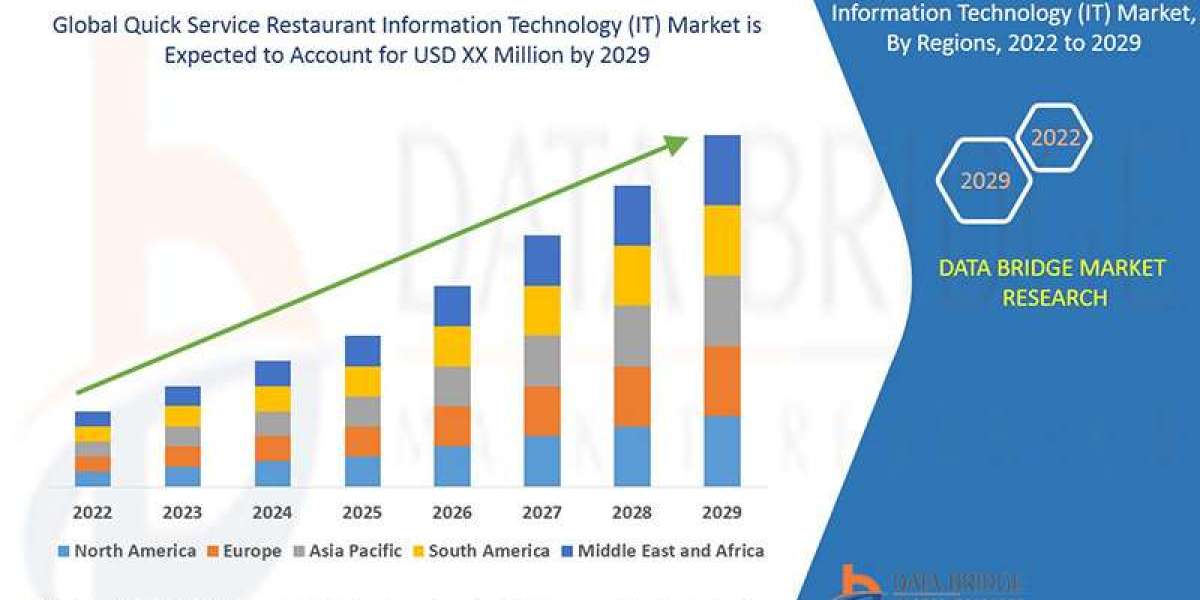Introduction
The Quick Service Restaurant (QSR) Information Technology (IT) Market involves the integration of advanced digital tools, software, and systems to optimize restaurant operations, enhance customer experience, and drive efficiency. This includes point-of-sale (POS) systems, digital payment platforms, mobile ordering apps, kitchen display systems, inventory management software, and customer relationship management (CRM) solutions. The objective of IT implementation in QSRs is to streamline ordering, reduce service times, manage data effectively, and improve operational decision-making.
The market’s relevance is increasing due to changing consumer expectations, the rise of online food delivery platforms, and the growing focus on contactless operations. The COVID-19 pandemic accelerated digital adoption, making IT systems indispensable for maintaining operational continuity. From digital kiosks to AI-driven demand forecasting, technology is reshaping how quick service restaurants operate and interact with customers.
Learn how the Quick Service Restaurant (QSR) Information Technology (IT) Market is evolving—insights, trends, and opportunities await. Download report: https://www.databridgemarketresearch.com/reports/global-quick-service-restaurant-it-market
The Evolution
The Quick Service Restaurant IT market has evolved significantly over the past three decades. Initially, restaurant operations relied heavily on manual systems and basic cash registers. The introduction of electronic point-of-sale (POS) systems in the 1990s marked the first major technological shift, enabling faster transactions and digital record-keeping.
In the early 2000s, QSRs began adopting integrated management systems to control inventory, manage suppliers, and track sales in real-time. As internet connectivity and mobile technology advanced, restaurants introduced self-service kiosks, mobile ordering, and digital loyalty programs to enhance convenience and customer engagement.
The past decade has seen rapid evolution driven by cloud computing, artificial intelligence, and big data analytics. Restaurants now leverage predictive analytics to optimize menu pricing, forecast demand, and minimize food waste. The integration of Internet of Things (IoT) devices into kitchen equipment has further improved efficiency by automating cooking and monitoring maintenance.
The evolution of QSR IT reflects a shift from traditional, reactive models to intelligent, data-driven operations designed to improve both profitability and the customer experience.
Market Trends
Rise of Digital Ordering Platforms
Mobile apps, self-service kiosks, and online ordering platforms are becoming standard across global QSR chains. Customers prefer digital channels for faster transactions and personalized experiences.AI and Machine Learning Adoption
Artificial intelligence is being used for predictive ordering, voice recognition systems, and dynamic pricing. Machine learning helps restaurants anticipate demand, reduce wait times, and optimize staffing.Cloud-Based POS Systems
Cloud technology allows restaurants to manage multi-location operations, access real-time sales data, and integrate seamlessly with delivery platforms.Growth of Contactless Payments
The adoption of digital wallets, QR codes, and NFC payment solutions has accelerated due to rising safety concerns and convenience demands.Integration of IoT Devices
Smart kitchen appliances connected via IoT enhance cooking precision, reduce energy consumption, and predict maintenance needs.Data-Driven Decision Making
Advanced analytics platforms help QSRs understand consumer behavior, improve menu performance, and increase retention through loyalty programs.Personalized Customer Experiences
Restaurants are leveraging CRM systems and data analytics to personalize offers, promotions, and order recommendations.Sustainability and Automation
The industry is adopting energy-efficient IT solutions and automated systems to minimize waste and promote sustainable operations.
Challenges
High Initial Implementation Costs
Deploying integrated IT infrastructure, including POS systems, kiosks, and data platforms, requires substantial investment, especially for small and medium-sized QSRs.Data Security and Privacy Risks
As QSRs collect customer data for analytics and personalization, the risk of cyberattacks and data breaches increases.Integration with Legacy Systems
Many existing restaurant operations rely on outdated systems, making integration with new digital tools complex and costly.Lack of Technical Expertise
Small operators often lack the technical knowledge required to manage advanced IT systems efficiently.Network Reliability Issues
Cloud-based and digital ordering systems rely heavily on internet connectivity, which can affect service continuity in low-connectivity regions.Changing Consumer Expectations
Continuous innovation is required to meet rapidly changing customer demands, which can challenge operational flexibility.Regulatory Compliance
Data protection and payment security regulations vary by region, requiring QSRs to ensure compliance across jurisdictions.Vendor Management Complexity
Managing multiple IT solution providers across various functions can complicate procurement and support operations.
Market Scope
Segmentation by Type
Hardware – POS terminals, kiosks, digital menu boards, kitchen display systems, sensors.
Software – Restaurant management software, payment processing software, CRM, analytics tools.
Services – Consulting, integration, maintenance, and managed IT services.
Segmentation by Application
Front-End Operations – Order management, billing, and payment processing.
Back-End Operations – Inventory control, kitchen management, and staff scheduling.
Customer Engagement – Loyalty programs, mobile applications, and marketing analytics.
Segmentation by Deployment Mode
On-Premise Solutions
Cloud-Based Solutions
Segmentation by Organization Size
Large Enterprises
Small and Medium Enterprises (SMEs)
Regional Analysis
North America
North America dominates the global market with a strong presence of major QSR brands such as McDonald’s, Starbucks, and Burger King. High digital literacy, robust internet infrastructure, and strong demand for convenience drive growth. The region’s focus on AI-driven analytics and mobile ordering systems enhances operational efficiency.
Europe
Europe is witnessing steady growth due to increased adoption of digital kiosks and mobile apps. The region emphasizes sustainability and data privacy, encouraging the development of eco-friendly IT solutions and secure cloud platforms. The United Kingdom, Germany, and France are leading adopters of advanced restaurant technologies.
Asia-Pacific
Asia-Pacific is the fastest-growing region, fueled by rapid urbanization, expanding fast-food chains, and increasing smartphone penetration. Countries such as China, India, Japan, and South Korea are witnessing a surge in mobile ordering and digital payment adoption. Local QSRs are investing in automation and data analytics to compete with global brands.
Latin America
Latin America’s growth is driven by rising consumer preference for quick dining options and expanding food delivery networks. Brazil and Mexico are leading the regional market, with increased adoption of mobile ordering and contactless payment technologies.
Middle East & Africa
The Middle East and Africa are emerging markets with growing investments in hospitality and food services. QSRs in the region are implementing cloud-based management systems and AI-powered analytics to improve service quality and customer retention.
End-User Industries
The primary end users include restaurant chains, cafes, food delivery companies, and franchise operators. QSR IT solutions are also increasingly adopted by catering services and food aggregators to manage orders, payments, and logistics efficiently.
Market Size and Factors Driving Growth
Data Bridge Market Research analyses that the quick service restaurant information technology (IT) market will exhibit a CAGR of 5.10% for the forecast period of 2022-2029.
Major Growth Drivers
Rising Demand for Digital Ordering and Delivery Platforms
Online food delivery and takeaway demand is fueling IT investments in QSRs for seamless customer interaction and order management.Increasing Smartphone and Internet Penetration
Mobile connectivity enables the widespread use of restaurant apps, loyalty programs, and online payments, accelerating market growth.Automation and Operational Efficiency
IT tools reduce manual labor, enhance accuracy, and optimize processes from order management to delivery tracking.Growing Focus on Customer Experience
Restaurants are adopting AI-based recommendation systems and analytics tools to deliver personalized experiences and improve satisfaction.Expansion of Cloud-Based Systems
Cloud deployment ensures scalability, centralized control, and easier updates across multiple restaurant locations.Emphasis on Sustainability and Waste Reduction
Smart technologies monitor energy consumption and optimize resource utilization, aligning with sustainability objectives.Increased Investment in AI and Analytics
Predictive analytics enables better inventory control, price optimization, and menu planning, reducing operational costs.Emerging Franchising Opportunities
Global expansion of QSR chains and local franchise development are boosting demand for integrated IT systems to maintain consistency and compliance.
Opportunities in Emerging Regions
Emerging economies present significant opportunities due to rapid urbanization, changing lifestyles, and growing disposable incomes. Asia-Pacific, in particular, will see strong adoption due to its expanding middle class and tech-savvy consumers. Local startups are collaborating with IT providers to introduce affordable digital solutions for small-scale QSRs.
Conclusion
The Quick Service Restaurant Information Technology Market is undergoing a period of rapid innovation driven by digital transformation, automation, and data intelligence. As the global food service industry evolves, QSRs are increasingly dependent on IT infrastructure to meet consumer expectations for speed, convenience, and personalization.
By 2035, technology will play a central role in redefining how restaurants operate, from predictive analytics that optimize menus to fully automated kitchens that ensure efficiency. The integration of artificial intelligence, IoT, and cloud computing will enable QSRs to reduce costs, enhance accuracy, and improve overall customer engagement.
Sustainability, data-driven insights, and customer-centric solutions will define the next phase of market evolution. Businesses investing early in digital transformation will gain a competitive edge and secure long-term growth in an increasingly technology-dependent marketplace.
FAQs
1. What is the Quick Service Restaurant IT Market?
The QSR IT market covers digital technologies and systems that enhance restaurant operations, including POS systems, mobile apps, analytics platforms, and automated kitchen solutions.
2. What is the market size of the QSR IT market?
The global market was valued at USD 16.2 billion in 2024 and is projected to reach USD 47.8 billion by 2035.
3. What drives growth in the QSR IT market?
Growth is driven by the rise of digital ordering platforms, mobile payments, AI adoption, and increasing demand for fast, convenient dining experiences.
4. Which technologies are transforming QSR operations?
AI, cloud computing, IoT, data analytics, and contactless payment systems are reshaping QSR operations globally.
5. Which region dominates the market?
North America leads the global market due to high digital adoption and strong investment by major QSR brands.
6. What are the major challenges faced by the market?
Key challenges include high implementation costs, cybersecurity risks, system integration issues, and a lack of skilled IT personnel.
7. What are the main components of QSR IT systems?
The main components include hardware (POS, kiosks), software (CRM, analytics), and services (consulting, maintenance).
8. How fast is the market expected to grow?
The market is forecasted to grow at a CAGR of 10.1% from 2024 to 2035.
9. Which trends are shaping the future of QSR IT?
Key trends include automation, cloud migration, sustainability, and AI-driven personalization.
10. What opportunities exist in emerging regions?
Asia-Pacific and Latin America offer significant opportunities due to rapid QSR expansion, digital adoption, and rising consumer spending.
Browse More Reports:
Global Natural Rubber Market
Global Online Entertainment Market
Global Pine Nuts Market
Global Polycystic Ovarian Syndrome (PCOS) Market
Global Potassium Chloride Market
Global Raman Spectroscopy Market
Global Radio-Frequency Identification Technology (RFID) Market
Global Silicon Fertilizer Market
Global Smart Health Watches Market
Global Solid State Battery Market
Global Talc Market
South America Agriculture Drone Market
Asia-Pacific Digital Lending Platform Market
Africa Digital Lending Platform Market
North America Olive Oil Market
About Data Bridge Market Research:
An absolute way to forecast what the future holds is to comprehend the trend today!
Data Bridge Market Research set forth itself as an unconventional and neoteric market research and consulting firm with an unparalleled level of resilience and integrated approaches. We are determined to unearth the best market opportunities and foster efficient information for your business to thrive in the market. Data Bridge endeavors to provide appropriate solutions to the complex business challenges and initiates an effortless decision-making process. Data Bridge is an aftermath of sheer wisdom and experience which was formulated and framed in the year 2015 in Pune.
Contact Us:
Data Bridge Market Research
US: +1 614 591 3140
UK: +44 845 154 9652
APAC : +653 1251 975
Email:- corporatesales@databridgemarketresearch.com






